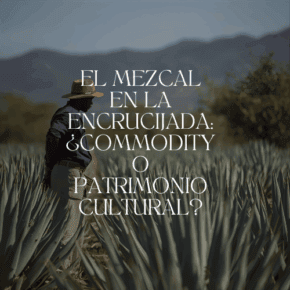
I recently had the pleasure of tasting Mezcal Vago’s mezcals which are slowly rolling out across the United States. Vago has a very emotional back story detailed on the site, the precis being that the brand’s main marketer and product lead, Judah Kuper, fell in love with a Mexican woman while surfing his way through Mexico. That led to marriage, a life in Oaxaca, and a romance with her family’s mezcal which he has rechristened Vago or vagabond in English for the vagabond’s path that got him where he currently is.
The longer story about the bottles, what goes into them, and everything else is almost, if not more interesting. Take Judah, he’s a personable guy with deep knowledge about mezcal. He’s well versed in all the industry gossip and he works the production line with his father-in-law and another palenquero so he knows the spirit from the inside out. While tasting we chatted about the ongoing debate over whether mezcal was distilled before the Spaniards got to Mexico and sundry other topics. Once you pull a thread in this business you get much more than a sweater, you get an entire cultural identity.
While Judah is the North American face of the business, he has an office in Oaxaca and is intimately involved in the entire production process. He works closely with Vago’s two palenqueros, Judah’s father-in-law Aquilino García López, and the epically named Salomón Rey Rodriguez. Per Judah 90% of the agave is estate grown with the remainder sourced through neighboring plots so that they maintain the same terroir.
Vago blends more than usual to add structure to their silvestres and they have a really intriguing field blend which is highly traditional but rarely seen in the United States. Judah says that all their “mixed agave mezcals are put together raw, roasted mashed and fermented together.” Their line is broad, right now it includes:
- Espadin: 100% from Candelaria Yegolé.
- Elote: A 100% Espadin base that soaks for 4 days in a toasted maiz mash and then distilled a third time. From Candelaria Yegolé.
- Olla de Barro Ensemble: A field blend composed of Casera, Coyote, Espadin, Arroqueno, and Mexicano. From Sola de Vega.
- Cuixe 90%/Espadin 10%. The Espadin was added to bring out the Cuixe’s full flavor. From Candelaria Yegolé.
- Mexicano 93/Espadin 7. Another blend that uses Espadin to bring out the majority agave’s flavor. From Candelaria Yegolé.
- Olla de Barro Tobala: This one is made from 17-year-old agaves. The fruit’s age comes across as incredibly complex. From Sola de Vega.
The diverse types of Vago mezcals reflects a high level of attention to the production process with an emphasis on environmental and cultural sustainability. Vago’s labels are plain text on a rough shod paper because they’re following a long tradition most recently highlighted by Mezcaloteca in detailing the entire production biography of the mezcal. Judah says “Trying to give the consumer the information they need to make an informed choice about a mezcal. ”
The paper itself is the fruit of the agave mash used for Vago’s mezcals. Paper artist Eric Ramirez from San Augustín Etla boils the left over agave mash from the still, grinds it, and dries it into a sheets on a screen. They then screen print the labels by hand. Getting deeper into the production process Aquilino García López uses some wood but mostly dried cactus to fuel his still, something that palenqueros have done for time immemorial but it’s a technique that might provide some respite from the shortages and high prices for firewood in Oaxaca, not to mention the looming environmental questions.
But one of the most interesting elements of Vago’s story is that most of their agaves are cultivated. Despite using an incredible variety of agaves that most other brands harvest wild Vago has been working with farmers to cultivate almost all the agaves used in their mezcal. As of this latest bottling the Cuixe is the only true silvestre. Judah told me that they plan to start cultivating the Cuixe in 2014 but that they don’t expect their first crop until 2017 so they’ll continue to use Cuixe silvestres at least until then. Otherwise the rest of their agaves are cultivated. As Judah told me “we have learned from Jalisco.”
Needless to say, this could be a strong model that preserves genetic diversity by keeping agaves wild and providing something of a genetic reservoir while ensuring that cultivated agaves don’t fall prey to the lure of monoculture. Plus it provides a great agricultural income to surrounding farmers and opens the door to a wider consumption of diverse mezcals. Since every story has two sides this could also lead to production on a more massive industrial scale but we’ll leave that discussion for another day. To top it off Vago is doing its part to sustain more of the cultural vibe around mezcal by being the US importer for Gran Mitla Sal de Gusano which we profiled last month.
If you’re looking to taste Vago Judah’s business partner Dylan Sloan will be conducting a tasting at La Urbana’s Mezcal Collective in San Francisco on January 21st. You can buy tickets through EventBrite.
Where can you find it?
Currently Mezcal Vago is available in Colorado, Texas, New York, Pennsylvania, Washington, and California. Vago expects to release in the District of Columbia, Louisiana, Kentucky, Oregon, and Idaho in the new year.
In Northern California look for Vago at












Leave a Comment